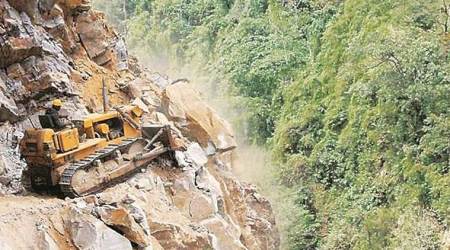 Rising temperatures and decreasing snowfall across the mountain range, leading to rapid melting of glaciers and water scarcity. (Express photo by Kavita Upadhyay)
Rising temperatures and decreasing snowfall across the mountain range, leading to rapid melting of glaciers and water scarcity. (Express photo by Kavita Upadhyay)
Experts on the Himalayas talk of rising temperatures and decreasing snowfall across the mountain range, leading to rapid melting of glaciers and water scarcity in human habitations.
“Climate change is impacting the Himalayas in many ways,” says Dr Anil Kulkarni, who is with the Bengaluru-based Indian Institute of Science’s (IISc) Divecha Centre for Climate Change, and has been studying Himalayan glaciers for the past four decades. “The snow cover in the lower-altitude Himalayan regions (2,500 metres-4,000 metres) has started to melt early,” he adds.
Quoting a study done on the Chandra Basin in the Western Himalayas between 1985 and 2009, Kulkarni says increasing temperatures due to climate change have resulted in small glaciers losing up to 70 per cent of their volume.
Professor A P Dimri of Jawaharlal Nehru University’s (JNU) School of Environmental Sciences, who has been doing research on the Himalayas for over two decades, especially with regards to weather patterns, says that between 1970 and 2010, warming rate was more in the higher-elevation regions than the lower-elevation ones in the mountain range.
“The precipitation which, a decade ago, would reach the higher altitudes is now getting limited to lower altitudes of up to 3,000 metres. This is leading to less snowfall and rainfall across the Indian Himalayas,” Dimri says.
H S Gusain, a scientist at the DRDO’s Snow and Avalanche Study Establishment (SASE) in Chandigarh, who has been studying snowfall patterns in the Himalayas for 15 years now, also talks about rising temperatures in the mountain range over the past two decades. “The Himalayan glaciers are retreating, the snow cover in the Himalayas is thinning, and the depth of snow cover is reducing,” he says.
A SASE study of the Gangotri glacier, located in the Central Himalayas, titled Observations of snow-meteorological parameters in Gangotri glacier region, concludes that between 2000 and 2012 “maximum and minimum temperature(s) reveal an increase of 0.9 degrees Celsius and 0.05 degrees Celsius respectively… Annual snowfall amount reveals a decrease of 37 cm.”
Kireet Kumar, a scientist at the Glacial Study Centre of the Almora-based G B Pant Institute of Himalayan Environment and Development, says a recent study done between 2013-2017 by them showed that the glacier, whose snout, Gaumukh, is located in Uttarakhand at 4,000 metres height, is “rapidly disintegrating”.
Gangotri is one of the largest Himalayan glaciers, from which originates the Bhagirathi river, one of the main tributaries of the Ganga. Currently the glacier is receding at 10-12 metres annually, Kumar says, adding “global warming” is “one of the many reasons”.
For all the latest India News, download Indian Express App

































